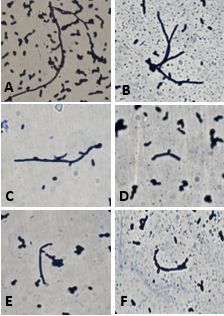Effect on antimicrobial activity of antifungal agents-silver nanoparticles combined treatments
DOI:
https://doi.org/10.37636/recit.v126971Keywords:
Nanoantibiotics, Silver Nanoparticles, Infectious Diseases, Synergy, Candida albicans.Abstract
Infectious diseases are a global public health problem; they are among the leading causes of death worldwide and consume a significant amount of resources. Fungi are the most common pathogens in humans and animals. Fungal infections incidence has increased more than 200%. Currently, antifungal agents are used for combating fungal infections, but there are many problems associated with their use, such as the emergence of resistant organisms, as well as the complexity related to the development of new antibiotics. In that sense, silver nanoparticles have proven to be an alternative solution to fight fungal infections due their capacity to inhibit fungal growth. In this work, we studied the antimicrobial activity of silver nanoparticles (AgNPs), antifungal agents (Amphotericin B and Fluconazole) and combinations of both, AgNPs-antifungals over the pathogenic dimorphic yeast Candida albicans. The antimicrobial tests were performed according to the CLSI ́s M27-A3 protocols. Combined AgNPs-antifungal treatments showed a different effect on antimicrobial activity. We found a synergistic effect of specific combined treatment, whereas antagonistic effect was observed with other combination.Downloads
References
R. Vazquez-Muñoz and A. Huerta-Saquero, "Nanomateriales con actividad microbicida: una alternativa al uso de antibióticos," Mundo Nano. Rev. …, vol. 7, no. 13, pp. 37-47, 2014. https://doi.org/10.22201/ceiich.24485691e.2014.13.48707 DOI: https://doi.org/10.22201/ceiich.24485691e.2014.13.48707
O. Brandt, M. Mildner, A. E. Egger, M. Groessl, U. Rix, M. Posch, B. K. Keppler, C. Strupp, B. Mueller, and G. Stingl, "Nanoscalic silver possesses broad-spectrum antimicrobial activities and exhibits fewer toxicological side effects than silver sulfadiazine," Nanomedicine Nanotechnology, Biol. Med., vol. 8, no. 4, pp. 478-488, 2012. https://doi.org/10.1016/j.nano.2011.07.005 DOI: https://doi.org/10.1016/j.nano.2011.07.005
R. John H. and G. Mahmoud A., M27-A3: Reference Method for Broth Dilution AST of Yeasts, 3rd ed. AstraZeneca; Case Western Reserve University, 2008. https://www.medicine.wisc.edu/sites/default/files/MIC.pdf
C. Longhi, J. P. Santos, A. T. Morey, P. D. Marcato, N. Duran, P. Pinge-Filho, G. Nakazato, S. F. Yamada-Ogatta, and L. M. Yamauchi, "Combination of fluconazole with silver nanoparticles produced by Fusarium oxysporum improves antifungal effect against planktonic cells and biofilm of drug-resistant Candida albicans," Med. Mycol., vol. 54, no. 4, pp. 428-432, 2016. https://doi.org/10.1093/mmy/myv036 DOI: https://doi.org/10.1093/mmy/myv036
K. Keuk-Jun, S. Sung, S. Moon, J. Choi, J. G. Kim, and D. G. Lee, "Antifungal Effect of Silver Nanoparticles on Dermatophytes," vol. 18, pp. 1482-1484, 2008. https://europepmc.org/article/med/18756112

Downloads
Published
How to Cite
Issue
Section
Categories
License
Copyright (c) 2018 Pérez Arriola Yarithza, Vázquez Muñoz Roberto, Bogdanchikova Nina, Huerta Saquero Alejandro

This work is licensed under a Creative Commons Attribution 4.0 International License.
The authors who publish in this journal accept the following conditions:
The authors retain the copyright and assign to the journal the right of the first publication, with the work registered with the Creative Commons Attribution license 4.0, which allows third parties to use what is published as long as they mention the authorship of the work and the first publication in this magazine.
Authors may make other independent and additional contractual agreements for the non-exclusive distribution of the version of the article published in this journal (eg, include it in an institutional repository or publish it in a book) as long as they clearly indicate that the work it was first published in this magazine.
Authors are allowed and encouraged to share their work online (for example: in institutional repositories or personal web pages) before and during the manuscript submission process, as it can lead to productive exchanges, greater and more quick citation of published work (see The Effect of Open Access).











